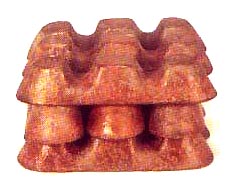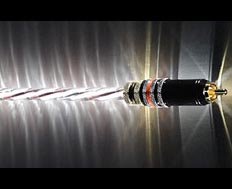 |
|
|
|
|
 |
|
|
|
|
|
I imagine this R&D phase gets hairily anal-retentive to truly cover all the bases?
|
|
 |
|
I call it scientific diligence. You see, I'm the kind of person who has to recreate and experience personally what anyone else may tell me. In the process of designing these speaker cables, I went through every possible permutation of foils, braids, conductors, stranding sizes, clockwise or counter-clockwise twists, placing the conductors on the perimeter versus the center. I had to prototype, listen and learn first-hand how altering these variables would affect the sound.
As the master chef, I needed to have all this information filed away in a data bank, to know what would happen when I adjusted a particular aspect of the design. This became of paramount importance during the final fine-tuning process when I incorporated the feedback from our beta testers, to nudge the performance in the direction that was universally indicated - a wee bit more salt, easier on the garlic. I needed to know what to do, exactly, to move the design toward the desired goal - changing 1% here, shaving off 2% there.
|
|
|
|
|
In short, it's about working the material. It's not like building an amplifier. You can't just adjust the value of a resistor, replace that Roederstein with a Hovland. With cable, all you have to work with is the raw material. That's what you must manipulate. That's much more difficult. You can't rely on that well-stocked parts inventory that allows endless substitutions until you arrive at the magical formula. With wire, you have to commit to a 5000' run clad in a specific dielectric just to find out what it sounds like. It's very labor- and cost-intensive. It takes an incredible commitment and investment to do it on the scale and level we at Shunyata insist on. As you know, our name comes from the Sanskrit to connote the primordial nothingness or silence that's at the core of all phenomena. That's what cable should be - utter silence, the total absence of coloration, the empty space out of which sounds arise with pristine purity.
|
|
 |
|
|
|
Now, people question why cable is so expensive. The way I look at it? Our cable isn't expensive. Disputing the final bill of raw materials, you can take any product, break it down into its raw constituents and complain that it costs hardly anything to make. A human being is probably worth, what - $20.50, if you broke it down into its chemical constituents, some carbon here, some calcium there, lots of water and accumulated preservatives? How much does it cost to gain knowledge? The time and effort that go into products is what contributes to their final cost.
You can pick up a disposable Kodak camera for five bucks or acquire a Leica or Hasselbladt for thousands. What's the difference? Time, effort, craftsmanship, performance. It's the same with what we do. Take our Aries interconnect. At $650, it competes with the best cables in the world that cost $4000 to $10,000. That's what makes it unique. To reach the pinnacle of performance - it takes a tremendous amount of research, time and effort.
In the case of the Aries, we employed a true Litz design in which 600 mono-filaments are individually insulated and then wound or wrapped such that they're all the same length. Without extreme care and finesse -- say you had a 6' cable -- the twisted filaments at the center won't travel the same winding distance as the ones on the circumference. You'd end up with discrepancies in conductor lengths. Some could be 8' long, others 8.25'. Obviously, this creates a smearing and blurring of arrival times destroying coherence. Our Aries wire is made such that very thin bundles are twisted with other thin bundles to eventually arrive at the final overall gauge without introducing any conductor length discrepancies.
|
|
|
But certainly, ours isn't the only true Litz made. We now use micro-thin membrane insulation to hold these three main conductor bundles together. If you were to look at the raw wire without its outer sleeve, you wouldn't see the dielectric. It's practically invisible. To strip it requires thermal techniques. Of course you realize that a single-ended coaxial RCA-terminated wire only requires two conductors. Instead, we use three. They're perimeter conductors that spiral around the hollow core of the cable such that even if we sent signal down only one of these conductors, the electromagnetic flux field would still be perfectly focused in the center of the wire. |
|
|
|
 |
|
Each time you send signal down a wire, the wire itself creates an opposing force. It tries to push back: Self-inductance. The larger the wire, the higher the self-inductance. Let's briefly switch back to power cords. People assume that if 12 gauge is good, 10 must be better. Pretty soon you arrive at 6- or larger gauge wire which is almost impossible to bend. Obviously you're trading something for something else. You need to transfer sufficient current which requires conductor size. Beyond a certain size however, the rising self-inductance becomes a greater problem than the gains in DC resistance. Of course to know the exact balance point between optimized current delivery and manageable self-inductance? That requires performing the necessary research.
|
|
|
|
|
With the Aries cable, we had to conduct multiple experiments to determine the appropriate conductor size. And I'm not talking computer simulation. I'm talking actual and laborious prototyping to compare minute offsets by ear, in a variety of beta systems. Whenever you send a signal through a wire, it creates an electromagnetic field around the conductor that expands and contracts in accord with the signal. Each time such a field cuts across another conductor, it generates a current in it. If a signal-carrying conductor radiates such a field into the return conductor, it causes a modulation. That effectively creates self-induced distortion caused by the geometry of the cable itself. DIYers solve this problem by suspending naked wires with the return conductors spaced apart by at least a foot. Well, unless you desired to turn your listening room into Spidey's gym where gnats perform chin-ups, that's terribly unrealistic for most of us.
|
|
 |
|
|
When you perform the requisite experiments, you'll notice how moving the return conductor only a small fraction from the hot leg yields huge improvements. Moving it farther than that yields smaller and smaller returns. In the Aries, we use strategic spacers to maintain consistent and optimized conductor separation. |
|
 |
|
|
|
|
| Let's touch on your concern over affordability. |
|
 |
|
|
|
I didn't enter this business to price-gauge. I entered it to offer superior products at fair prices that common music lovers could still afford. Before this aspect of our discussion turns into a major tangential detour (which it did off the record past the actual interview portion) let's give your readers a few more areas in which cable designers must roam to advance the state-of-the-art.
Cables exhibit nodal patterns just like room-mode standing waves that are a function of a room's spatial relationships of length versus width versus height. In a cable, these resonances are tied to physical length just like resonating guitar strings. They can cause peaks or dips in perceived bass response. Those aren't measurable under steady-state test bench signals since they only occur during transient peaks with actual music. If a cable is cut to a particular length that happens to coincide with the wavelength of the anomaly, it could be compounded. People have stumbled upon this unwittingly. They noticed that a particular interconnect sounds better at 2 meters than one. They observe that reducing high-level cable length to a few inches between monoblock and speaker sounds far worse than a longer cable run. The latter is very common. Most speaker cable requires a minimum length of a few feet below which it begins to exhibit response aberrations.
Whenever you're transmitting signal -- which, naturally, has a certain frequency -- there's the very real potential for resonances. Reflections akin to digital jitter as well. You see, cable is the transmission medium between two interfaces that each exhibit a characteristic impedance - an input and output impedance. Unfortunately in audio, they don't match. (Cracks up.) You have mismatched input and output impedances and you're connecting them with a wire that has its own characteristic impedance but different again from the other two. (Cracks up again.) And people wonder why cables sound different from system to system! But there's more. Each time there is a connection between metal and metal, there's an electrical potential. Say you placed zinc and gold together to be drastic. It creates a type of battery. These junctions are similar to semi-conductor devices in that they create a certain type of noise depending on the type of signal you send across this junction. So these are some of the things a cable designer considers.
|
|
 |
|
| Sounds like a full plate to me. And it ain't Sushi. |
|
|
 |
|
|
|
When I went to work on our signal cables, I wasn't sure we'd ever go into production. While there are many hideously overpriced cables on the market, there are many truly excellent affordable designs as well. Had everything possible already been done? I didn't know. That's why it took us four years. It required a comprehensive assessment of the status quo to discover ways in which it could be improved. I maintain a reference library of sorts where I keep competing designs that excel in certain areas, as a reminder about what is possible, say in terms of dynamics, transparency, speed, top-end extension. I won't release a new product until it captures at least 90% of these reference standards, in all the different aspects of performance which they jointly represent. I wouldn't put our name on a new product unless it truly meant something. I want people to insert our cables into their systems and immediately, without hesitation, recognize our sound.
What is our sound? It's one of purity, balance and musicality. I never conform to a specific design parameter over others. Design has to retain balance, remain unselfishly in the service of the final outcome. I won't make a cable more transparent, quieter, "slammier", just so it can be sold in the showroom as yet another -- ultimately short-lived -- novelty. If such isolated peak results mean upsetting the natural overall balance of qualities, I'm not interested. Any of my cables has to be an all-'round performer. It has to work in a variety of systems, under a variety of conditions, and display consistent, repeatable results. Hence we have assembled a wonderful group of trusted beta testers -- which include many fellow manufacturers by the way -- who assist us during the fine-tuning period of this lengthy research & development phase. [Below see reference system of Grant Samuelsen, Shunyata's sales manager, ex-SoundStager and heavily involved in the company's beta-testing process.]
|
|
|
 |
|
|
|
 |
 |
|
|
 |
|
|
|
|
|
|
|
|
|
|
|
|
|
|
|
|
|
|
|